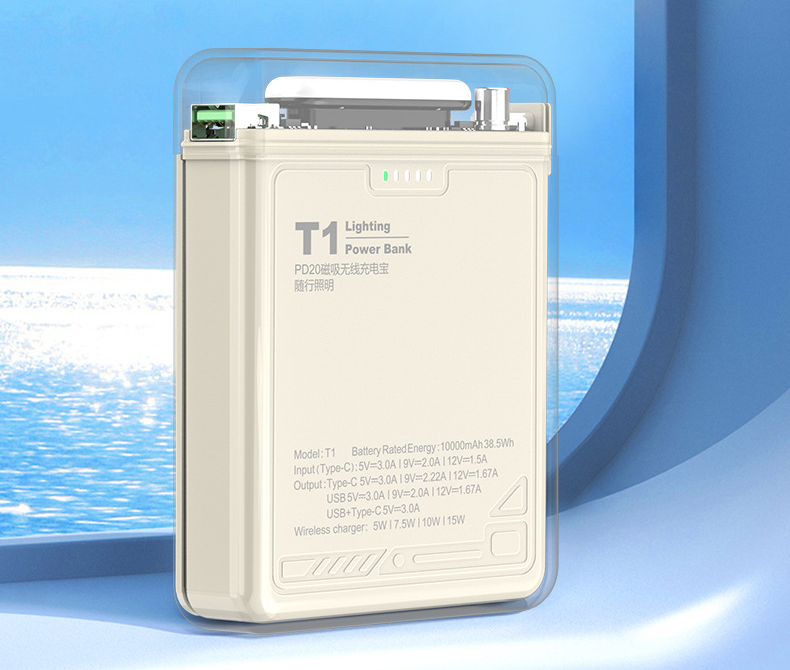Welcome to the world of power banks, where portable charging solutions empower our digital lifestyles. As indispensable companions for our electronic devices, power banks come packed with a wealth of technical specifications. While these numbers and terms might seem daunting at first glance, fear not! In this article, we will embark on a journey to demystify power bank specifications, unraveling the meanings behind each key specification. By the end of this article, you will have a clear understanding of the meanings behind the specifications on power banks, empowering you to make informed choices when selecting the perfect power bank for your devices.
Table of Contents
ToggleCapacity (mAh):
The capacity of a power bank is usually denoted in milliampere-hours (mAh). It represents the amount of charge the power bank can store. A higher mAh rating indicates a larger capacity, meaning it can charge your devices more times before it needs to be recharged itself.
Output (*V/*A):
The output is a power bank to charge mobile phones, tablets, etc., usually measures in Voltage (V) and Current (A), the standard is 5V/2A.
Input (*V/*A):
The input is to charge the power bank with the charger, also measures in Voltage (V) and Current (A), the standard is 5V/2A.
Rated Capacity:
The rated capacity refers to the total amount of electrical charge that the power bank can actually output. Typically measured in milliampere-hours (mAh) or watt-hours (Wh).
Power Delivery (PD) and Quick Charge (QC):
These are fast-charging technologies that can significantly speed up the charging process. Power Delivery is a USB standard that allows for higher voltage and current levels, while Quick Charge is a technology developed by Qualcomm. If your device supports either of these technologies, consider getting a power bank that does too.
Battery Type:
Most power banks use either Lithium-Polymer (Li-Po) or Lithium-Ion (Li-Ion) batteries. Li-Po batteries are generally lighter and more efficient but also costlier than Li-Ion batteries.
Size and Weight:
Though not technical specifications, size and weight are crucial factors to consider, especially if you plan on carrying your power bank around. Higher-capacity power banks are usually heavier and larger.
Absolutely, let’s take a deeper look at the different types of interfaces or ports that you might find on a power bank:
Micro USB:
Micro USB ports were once the standard for many devices, including smartphones, tablets, and power banks. While they’ve been largely replaced by newer interfaces in many high-end devices, many power banks still use micro USB ports for charging the power bank itself. They don’t support the fastest charging speeds compared to more recent standards, but they’re still common due to their wide compatibility.
USB-A:
This is the standard rectangular USB port that you’re likely familiar with from computers, car chargers, wall plugs, and many other devices. On a power bank, a USB-A port is typically used as an output for charging other devices. Most power banks feature at least one USB-A port, though high-capacity models might have two or more.
Type-C:
Type-C is the newest and most versatile USB standard. It has a reversible connector, meaning you don’t have to worry about which way you’re plugging it in. It also supports the fastest charging speeds, often in conjunction with USB Power Delivery (USB PD), and can handle power both ways. On a power bank, a USB-C port can often be used both to charge the power bank and as an output to charge other devices.
Lightning:
Lightning is a proprietary interface from Apple. It’s used on the iPhone, iPad, and some iPod models. Some power banks include a Lightning port, mainly to allow the power bank to be charged with the same cable used for an iPhone or iPad. This can be a handy feature if you’re an Apple user and want to carry fewer cables.
Remember, the interfaces or ports on your power bank determine what devices you can charge with it, and how the power bank itself gets charged. Be sure to consider what devices you’ll want to charge when you’re choosing a power bank.
Now that we’ve covered some of the basic features and specifications, let’s delve into a more advanced but crucial concept that greatly influences a power bank’s performance:
Wattage (W):
The ‘W’ stands for ‘Watt’, which is a unit of power. Watts are used to express the rate at which energy is transferred or converted. Simply put, the higher the wattage, the more power the power bank can deliver at once, leading to faster charging times for your devices.
Here’s how you can calculate the wattage:
Wattage is determined by the formula: P = V * I, where:
P stands for power and is measured in watts (W)
V stands for voltage and is measured in volts (V)
I stands for current and is measured in amperes (A)
For instance, if a power bank is rated with an output of 5V/2A, it means the maximum power output it can provide is 5V * 2A = 10W. When output is ≥ 18W, the power bank is determined as fast charge. Currently PD22.5W is the most popular choice.
The wattage can also influence whether a power bank is capable of charging larger devices, such as laptops. For example, many laptops require power banks with an output of at least 30W to 60W for efficient charging.
Understanding the wattage of a power bank is crucial because it gives you an idea of its performance and compatibility with your devices. However, it’s essential to remember that the device you are charging also plays a significant role in the charging process. Your device’s internal circuitry will only draw the current it needs and can handle, even if the power bank can deliver more.
While considering the capacity (mAh) of a power bank is important, knowing the wattage will give you a more comprehensive understanding of how quickly and effectively it can charge your devices.
Conclusion:
Understanding the specifications of a power bank – the capacity (mAh), output and input (Amps), USB Ports, battery type, safety features, and the all-important wattage (W) – can significantly enhance your ability to choose the right product. Whether it’s for charging your smartphone on a long commute, keeping your laptop powered during a business trip, or ensuring your camera never runs out of juice on a photography expedition, there’s a suitable power bank out there for everyone.
Remember, the best power bank isn’t necessarily the one with the highest specs, but rather the one that best fits your personal needs and the requirements of your devices. With the knowledge you’ve gained from this article, you’re now equipped to make an informed decision when purchasing your next power bank.
We hope this guide has been helpful in demystifying power bank specifications for you. Happy shopping, and stay powered up wherever you go!



